The 16th century was one of the most momentous times in world history. In 1517, the blessed Reformation began with Saint Marin Luther. In 1527, King Henry VIII divorced Roma permanently; In 1605, the explosive Gunpowder Plot almost succeeded, and in 1620 the Pilgrim Fathers established Israel in the New World Wilderness!
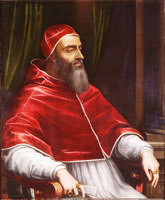 Pope Clement VII (1478–1534). Pope from 1523 to 1534. |
|
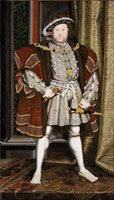 King Henry VIII (1491–1547). Reigned from 1509 to1547. |
Henry had just sent a shipload of gold to Pope Clement and everyting was set for the ponfiff to grant the king his divorce. With Pope Clement as his prisoner, Charles kept the gold, and the king never obtained his divorce from Catherine of Aragon.
That debacle led to Henry divorcing Roma permanently. However, Henry had powerful enemies in his kingdom, led by Sir Thomas More, who were determined to maintain the status quo Babylonian Captivity. Henry's wife, Queen Anne Boleyn, was beheaded, and her daughter, the future Sultana Elizabeth I, became sovereign in 1559.
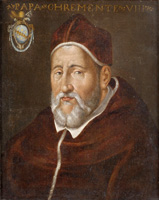 Pope Clement VIII (1536–1592). Pope from 1592 to March 1605. |
|
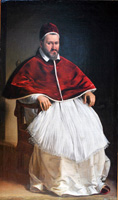 Pope Paul V (1550–1621). Pope from May 1605 to 1621. |
The next pontiff, Paul V, was totally subservient to Jesuit general Aquaviva, so he issued a plenary indulgence (license to kill) to all who participated in the Gunpowder Plot, and he said that they were doing a "holy work most pleasing to God."
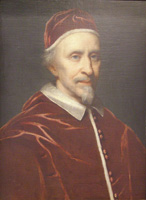 Pope Clement IX (1600–1668). Pope from 1667 to 1669. |
|
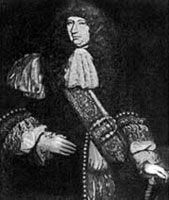 Sir George Downing (1623–1684). |
The Fifth Monarchy Men believed that Britannia would be revived Israel . . . but it wasn't Old England . . . but New England . . . where the new Jerusalem would be established.
The Bible says that "a leopard cannot change his spots," so a counter-revolution restored the monarchy under King Charles II. Charles launched the greatest manhunt in the history of the world to find the "regicides" who signed his father's death warrant. The bloodhounds were led by Sir George Downing—the British Judas Iscariot!
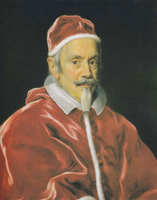 Pope Clement X (1590–1676). Pope from 1670 to 1676. |
|
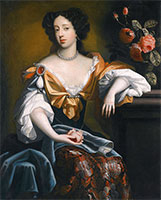 Mary of Modena (1658–1718) was the daughter of Pope Clement X. |
After the death of Charles II, his son James II, followed him on the throne. His wife, Mary of Modena, could not produce a Prince of Wales, so she faked the birth, and introduced a nun's baby instead.
That event led to the invasion of William of Orange to save the country from the Warming Pan Plot. James fled to France, and then to Ireland, where he made a last stand at the Battle of the Boyne. He was defeated and never returned to Britannia. The warming pan baby survived under the name James Francis Edward Stuart.
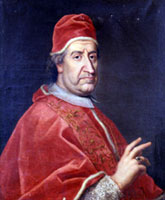 Pope Clement XI (1649–1721). Pope from 1700 to 1721. |
|
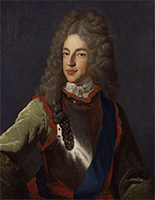 James Francis Edward Stuart (1688–1766). |
The 18th century, which began with Clement XI in the Chair of St. Peter, was just as violent as the previous century. However, the battleground had moved westward to the New World, and the New Jerusalem still clung precariously to the eastern seaboard of North America.
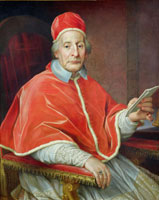 Pope Clement XII (1652–1740). Pope from 1730 to 1740. |
|
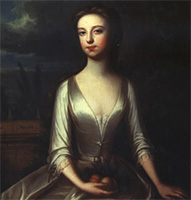 Lady Diana Spencer (1710–1735). |
Sir Robert Walpole—the first Prime Minister of Great Britain—knew the law and he vetoed the marriage. That history was repeated in the 20th century when another Catholic named Lady Diana Spencer married the Prince of Wales.
Clement XIII was pontiff during the Seven Years' War or the First World War. That conflict was actually started by George Washington when he attacked a French settlement in Ohio. It soon spread into a worldwide conflagration.
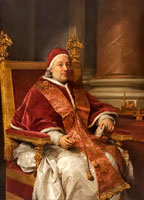 Pope Clement XIII (1693–1769). Pope from 1758 to 1769. |
|
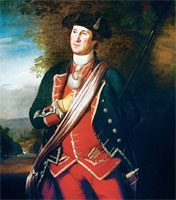 Colonel George Washington (1732–1799). |
The war was a disaster for France, and King Louis XV knew that the Jesuits were the instigators of the conflict. The king was eager to ban the firebrands from his kingdom . . . but fearful because of a Jesuit assassination attempt on his life in 1757.
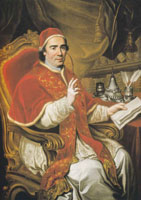 Pope Clement XIV (1705–1774). Pope from 1769 to 1774. |
|
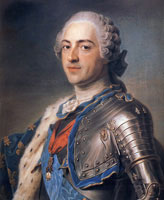 King Louis XV (1710–1774). Reigned from 1715 to 1774. |
On July 21, 1773, this "infallible" Pope banned the Jesuit order by a perpetual decree never to be rescinded. It cost him his life as he was given the cup of Borgia shortly thereafter and died a horrible lingering death:
Even the Papal States refused to give the Jesuits a refuge, and they were finally dumped on the island of Corsica. It was no coincidence that the "real Apollyon" was born on that island in 1769.And to this end a member of the regular clergy, recommendable for his prudence and sound morals, shall be chosen to preside over and govern the said houses; so that the name of the Company shall be, and is, for ever extinguished and suppressed. (Bull of Suppression of Pope Clement XIV).
Pope Clement XIV was the last Clement in the nightmarish Papal dynasty. The best way to rescue Catholics . . . and Muslims . . . from the Babylonian system is to present a true history of the Papal dynasty:
Flee out of the midst of Babylon, and deliver every man his soul: be not cut off in her iniquity, for it is the time of JEHOVAH's vengeance; he will render unto her a recompense (Jeremiah 51:6).
And I heard another voice from heaven saying, "Come out of her, my people, that ye be not partakers of her sins, and that ye receive not of her plagues" (Apocalypse 18:4).
Vital links
Reference
Norwich, John Julius. Absolute Monarchs: A History of the Papacy. Random House, New York, 2011.